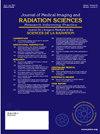分析 BMI 对俯卧位放射治疗中乳腺癌设置错误的影响:手动和自动图像匹配的比较
IF 1.3
Q3 RADIOLOGY, NUCLEAR MEDICINE & MEDICAL IMAGING
Journal of Medical Imaging and Radiation Sciences
Pub Date : 2024-10-01
DOI:10.1016/j.jmir.2024.101526
引用次数: 0
摘要
在放射治疗中,病人定位的精确性至关重要,尤其是在使用俯卧位以最大限度地减少对危险器官(OAR)的照射时。这项研究探讨了体重指数(BMI)对俯卧位设置误差的影响,强调了手动和自动图像匹配技术之间的区别。研究分析了27名体重正常患者和88名超重患者的数据,这些患者在2023年2月至11月期间接受了VARIAN iX直线加速器治疗,并通过每周一次的机载成像(OBI)进行了评估。采用手动和自动匹配方法来评估设置误差(侧后方(X 轴)、颅尾(Y 轴)、前胸(Z 轴)、偏航)偏差,并将其与患者的体重指数相关联。分析表明,在自动匹配中,体重指数较高的患者 X 轴的平均位移值为 0.192±0.2296 厘米(P<0.05),Yaw 轴的平均位移值为 0.118±0.3590 度(P<0.05),明显高于体重指数正常的患者。手动匹配强化了这一发现,BMI 较高的患者在 X 轴的位移明显增加,平均为 0.344±0.2828 厘米(P<0.05)。这些结果表明,体重指数较高的患者在俯卧位放射治疗过程中保持精确定位面临着更大的挑战,可能会影响治疗的精确性。通过应对这些定位挑战,有可能提高治疗精度,确保更有效的放疗效果。本文章由计算机程序翻译,如有差异,请以英文原文为准。
Analyzing the Impact of BMI on Breast Cancer Setup Errors in Prone Position Radiation Therapy: A Comparison of Manual and Automated Image Matching
In radiation therapy, the precision of patient positioning is crucial, particularly when using the prone position to minimize exposure to organs at risk (OAR). This investigation explores the effect of Body Mass Index (BMI) on setup errors in prone positioning, emphasizing the distinction between manual and automated image matching techniques. Data from 27 patients with normal weight and 88 overweight patients, treated from February to November 2023 with the VARIAN iX Linear Accelerator and assessed through weekly On-Board Imaging (OBI), were analyzed. Both manual and automated matching methods were utilized to evaluate setup error (Laterolateral(X axis), Craniocaudal (Y axis),Anterioposterior (Z axis), Yaw)deviations, correlating these with the patients' BMI.
The analysis demonstrated that in automated matching, patients with a higher BMI showed mean displacement values of 0.192±0.2296 cm (P<0.05) in the X axis and 0.118±0.3590 degree (P<0.05) in the Yaw axis, significantly higher than those with a normal BMI. Manual matching reinforced this finding, with a notable increase in displacement for higher BMI patients in the X axis, averaging 0.344±0.2828 cm (P<0.05). These results reveal that patients with higher BMI face greater challenges in maintaining precise positioning during prone radiation therapy, potentially affecting treatment precision.
This study shows the necessity for customized positioning strategies in prone radiation therapy for patients with higher BMI. By addressing these positioning challenges, it is possible to improve treatment precision and ensure more effective radiation therapy outcomes.
求助全文
通过发布文献求助,成功后即可免费获取论文全文。
去求助
来源期刊

Journal of Medical Imaging and Radiation Sciences
RADIOLOGY, NUCLEAR MEDICINE & MEDICAL IMAGING-
CiteScore
2.30
自引率
11.10%
发文量
231
审稿时长
53 days
期刊介绍:
Journal of Medical Imaging and Radiation Sciences is the official peer-reviewed journal of the Canadian Association of Medical Radiation Technologists. This journal is published four times a year and is circulated to approximately 11,000 medical radiation technologists, libraries and radiology departments throughout Canada, the United States and overseas. The Journal publishes articles on recent research, new technology and techniques, professional practices, technologists viewpoints as well as relevant book reviews.
 求助内容:
求助内容: 应助结果提醒方式:
应助结果提醒方式:


